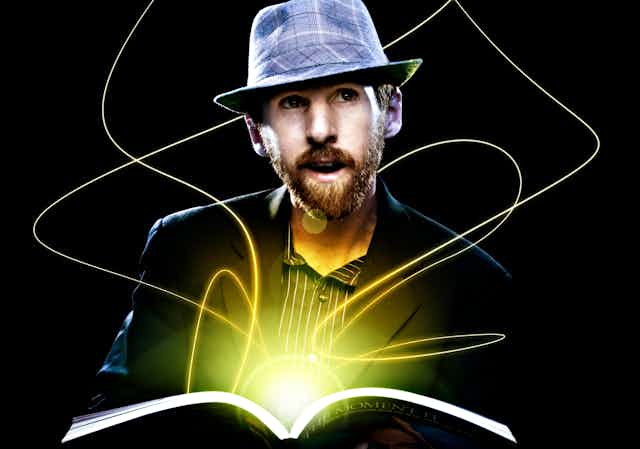The Uncertainty Principle, introduced by Heisenberg in 1927, applies to observations of the properties of the quantum world, which is typically microscopic in scale. As I explained a few months ago, it has the profound implication that we cannot know everything.
Earlier this month, a paper from physicists in the University of Toronto was published in the prestigious journal Physical Review Letters (public-access pre-publication version here) that at first sight seems to show that their experimental results violate Heisenberg’s principle.
How could the Heisenberg Uncertainty Principle (HUP), which has been fundamental to physics for more than 80 years, suddenly be disproven? The Toronto experiment actually used some of my own research, so I am well-placed to explain what is really going on.
Not really a principle
First, as I explained previously, Heisenberg’s “uncertainty principle” is not really a fundamental principle at all. It is actually a consequence of something more fundamental, namely quantum mechanics (QM). This theory applies to all forms of matter and energy (as far as we can tell) and is extremely well tested.
The experimentalists in Toronto, led by Aephraim Steinberg, do not claim to have disproven quantum mechanics. Indeed, the design of their apparatus relies on QM being correct.
Moreover the experimental violation they report was predicted using QM, in a 2010 paper by Austin Lund and me.
So … if the HUP is a consequence of QM, but QM has not been violated, what exactly is the paper claiming?
One principle, many relations.
To appreciate the paper, you have to understand that the HUP is a general principle which has many different forms. The most useful forms are quantitative relations between various quantities related to uncertainty.
The simplest uncertainty relation, which can be derived quite easily using QM, can be expressed as follows:
(1) Δq x Δv > ħ/m.
Here Δq is the uncertainty in the position of a particle (in metres), Δv is the uncertainty in its velocity (in metres per second), m is its mass in kg, and ħ is a very small constant (Planck’s constant) approximately equal to 10-34 = 0.00 … 001, where there should be 34 zeros here.
Because the two uncertainties multiplied together in equation (1) must be greater than some number, this means that it is not possible for both Δq and Δv to be zero. Hence you cannot be certain of both the position and velocity of the particle – you cannot know everything.
You might be think that if you want to know both you could find them out by first measuring the velocity, then the position. But this doesn’t work, because a perfect (zero error) measurement of position will necessarily disturb the velocity, and vice versa.
This fact is another form of the HUP, relating the error in a measurement of position, e(q), and the associated disturbance in the velocity d(v). You might guess that they should be related by
(2) e(q) x d(v) > ħ/m.
This is a very reasonably guess, and it is essentially the “measurement–disturbance relation” which Heisenberg guessed in 1927.
The surprising thing is that this guess is wrong. According to QM, multiplying the error by the disturbance can be less than ħ/m. In fact, it can even equal zero, a fact which has only been fully appreciated in the last ten years.
The Toronto experiment actually measured the spin of a single photon, not the position of a particle. But there is an analogous uncertainty principle relating the spin in different directions.
Using the technique which Lund and I had proposed, based upon “weak-valued probabilities”, Steinberg and colleagues were able to directly measure the appropriate error (e) and disturbance (d) quantities, and show that they violate Heisenberg’s measurement-disturbance relation (2).
Ozawa’s measurement-disturbance relation
But if Heisenberg’s measurement–disturbance relation (2) is wrong, why can’t you measure position without disturbing the velocity, and hence find out both, in violation of the original uncertainty relation (1)?
The short answer is: because it is impossible according to QM. But that’s not a very satisfying answer, because the mathematics of QM is hard to understand, unlike the mathematics of (1) and (2).
Thankfully, QM allows us to derive a different measurement-disturbance relation that makes everything right again. This was first shown by Japanese theorist Masanao Ozawa, in 2003 (public-access pre-publication version here). Ozawa’s measurement-disturbance relation includes the terms in Heisenberg’s (wrong) measurement-disturbance relation (2) as well as the uncertainties that appear in his (right) uncertainty relation (1):
(3) e(q) x d(v) + e(q) x Δv + Δq x d(v) > ħ/m.
Steinberg’s lab in Toronto also tested the spin-analogue of this relation experimentally, and found, as expected, that it always held up.
You still can’t know everything
Ozawa’s relation (3) allows for the possibility that either e(q) or d(v) can be zero – which is not possible according to Heisenberg’s relation (2) – provided Δq or Δv are large enough. But it is still not possible for both of them to be zero, because that would make the left-hand-side of (3) equal to zero, whereas the right-hand-side is non-zero.
Thus Ozawa’s relation still guarantees that it is not possible to make a zero-error measurement of position with no disturbance of the velocity.
It still guarantees that you can’t find out everything, upholding the Heisenberg uncertainty principle, and leaving quantum mechanics in place as the best theory we have.

